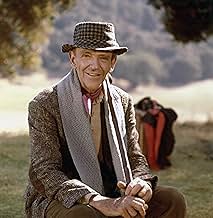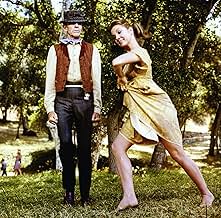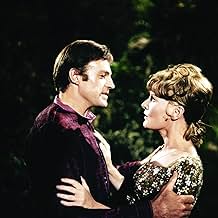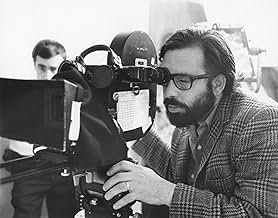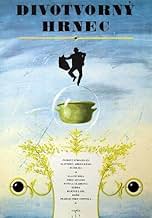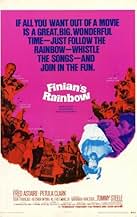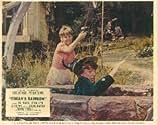CALIFICACIÓN DE IMDb
6.1/10
4.5 k
TU CALIFICACIÓN
Un inmigrante irlandés y su hija se trasladan al sur de Estados Unidos con una mágica pieza de oro que cambiará la vida de la gente, incluidos un granjero en apuros y ciudadanos afroamerican... Leer todoUn inmigrante irlandés y su hija se trasladan al sur de Estados Unidos con una mágica pieza de oro que cambiará la vida de la gente, incluidos un granjero en apuros y ciudadanos afroamericanos amenazados por un político intolerante.Un inmigrante irlandés y su hija se trasladan al sur de Estados Unidos con una mágica pieza de oro que cambiará la vida de la gente, incluidos un granjero en apuros y ciudadanos afroamericanos amenazados por un político intolerante.
- Dirección
- Guionistas
- Elenco
- Nominado a 2 premios Óscar
- 1 premio ganado y 9 nominaciones en total
Brenda Arnau
- Sharecropper 'Necessity'
- (sin créditos)
Charles Carter
- Sharecropper
- (sin créditos)
Sterling Clark
- Sharecropper
- (sin créditos)
Robert Cleaves
- Geologist
- (sin créditos)
Robert Cole
- Sharecropper
- (sin créditos)
Willie Covan
- Sharecropper
- (sin créditos)
Evelyn Dutton
- Sharecropper
- (sin créditos)
Opiniones destacadas
The film version of "Finian's Rainbow" was conceived at a time when the public's interest in movie musicals was on the wane; in fact, in light of the poor critical reception accorded "Camelot" the year before, studio head Jack Warner would have been content to pull the plug on what he perceived as another sure-fire disaster. To an extent, his feelings were justified - what had been a daringly provocative look at racial strife in the deep American South as seen through the eyes of a scheming Irishman and his less-than-supportive daughter when it debuted on Broadway in 1947 was no longer very pertinent twenty-one years later, and the fairy tale aspects of the plot - which included the hyperactive antics of a leprechaun intent on retrieving his "borrowed" pot of gold - were going to be a hard sell in 1968. The score, although exquisitely timeless and highly recognizable, was old-fashioned in its theatricality and not likely to result in a best-selling cast album. Furthermore, directing the project was a virtual unknown, a "hippie" from northern California named Francis Ford Coppola, with only one prior film - a non-musical - to his credit. Given the odds the movie was doomed, Warner basically maintained a "hands-off, don't-ask, don't-tell" policy and simply hoped for the best.
The end result may not have been the "best", but it is considerably better than most critics described it upon its release. The overlong book, with several insignificant sub-plots, could have used some judicious trimming. Tommy Steele's performance as Og, the slowly-turning-into-a-human leprechaun, is frantically overblown. The film's editing is criminal in that Fred Astaire's feet are often unseen in his dance routines. And the attempt to blend reality and make-believe results in an awkwardly uneven balance of the two - Coppola would have been far more successful had he decided to emphasize the whimsical and play down the outdated political aspects of the story. But for all these shortcomings, "Finian's Rainbow" - from its spectacular opening credits to its nicely staged farewell to Finian - almost a goodbye to Astaire himself, for whom this would be his last dancing role - is pleasant entertainment, buoyed by its familiar score and anchored by the presence of Petula Clark, whose delightfully fresh and sweetly seductive performance is the true gold to be discovered here. At the time known in the States as the pop singer responsible for the mega-hit "Downtown", Clark drew on her previous experience as an actress in mostly grade-B British films and developed a character whose acceptance of a leprechaun hiding in the backyard well is as easily believed as her skepticism regarding her father's plot to multiply his borrowed gold by burying it in the shadows of Fort Knox and her fiancé's plans to grow mentholated tobacco. The Arlen/Harburg score - including such standards as "How Are Things in Glocca Morra?" and "Look to the Rainbow" - could well have been composed specifically for her voice, which wraps itself around each note with a hint of a brogue and - in the case of "Old Devil Moon" - a raw sensuality suggesting the woman inside the sweet Irish colleen. Deservedly, Clark was nominated for a Best Actress Golden Globe for her portrayal of Sharon McLonergan, and if for nothing else, her performance makes "Finian's Rainbow" definitely worth a look-see.
The end result may not have been the "best", but it is considerably better than most critics described it upon its release. The overlong book, with several insignificant sub-plots, could have used some judicious trimming. Tommy Steele's performance as Og, the slowly-turning-into-a-human leprechaun, is frantically overblown. The film's editing is criminal in that Fred Astaire's feet are often unseen in his dance routines. And the attempt to blend reality and make-believe results in an awkwardly uneven balance of the two - Coppola would have been far more successful had he decided to emphasize the whimsical and play down the outdated political aspects of the story. But for all these shortcomings, "Finian's Rainbow" - from its spectacular opening credits to its nicely staged farewell to Finian - almost a goodbye to Astaire himself, for whom this would be his last dancing role - is pleasant entertainment, buoyed by its familiar score and anchored by the presence of Petula Clark, whose delightfully fresh and sweetly seductive performance is the true gold to be discovered here. At the time known in the States as the pop singer responsible for the mega-hit "Downtown", Clark drew on her previous experience as an actress in mostly grade-B British films and developed a character whose acceptance of a leprechaun hiding in the backyard well is as easily believed as her skepticism regarding her father's plot to multiply his borrowed gold by burying it in the shadows of Fort Knox and her fiancé's plans to grow mentholated tobacco. The Arlen/Harburg score - including such standards as "How Are Things in Glocca Morra?" and "Look to the Rainbow" - could well have been composed specifically for her voice, which wraps itself around each note with a hint of a brogue and - in the case of "Old Devil Moon" - a raw sensuality suggesting the woman inside the sweet Irish colleen. Deservedly, Clark was nominated for a Best Actress Golden Globe for her portrayal of Sharon McLonergan, and if for nothing else, her performance makes "Finian's Rainbow" definitely worth a look-see.
I remember seeing this film when it was first released. I absolutely hated it - too slow-moving, and the male romantic lead was a cipher. Even the songs were manipulated to the point that I could barely stand to listen to them. Tommy Steele was far too frenetic as Og, the leprechaun. Its saving graces were Fred Astaire, Petula Clark (although she seemed too old in the role of Sharon), and Keenan Wynn. I've avoided it like the plague ever since.
Tonight, thanks to Turner Classic Movies, I finally watched it again. And you know what? It's a lot better than I remembered. I don't know what has caused the turnabout in my opinion, except perhaps the lack of quality of most of the musical films that have come along since FINIAN'S RAINBOW in 1968. It still has a few longueurs, but generally it's very enjoyable. Even Tommy Steele isn't too bad. Don Francks is still dramatically stiff, but he's better than I remembered, and he sings well. And oh, those songs! It's a shame that "Necessity" was cut, but otherwise, what a string of melody - How are Things in Glocca Morra, Old Devil Moon, When I'm not Near the Girl I Love, and more.
Thank you, TCM, for giving me a second chance with this film!
Tonight, thanks to Turner Classic Movies, I finally watched it again. And you know what? It's a lot better than I remembered. I don't know what has caused the turnabout in my opinion, except perhaps the lack of quality of most of the musical films that have come along since FINIAN'S RAINBOW in 1968. It still has a few longueurs, but generally it's very enjoyable. Even Tommy Steele isn't too bad. Don Francks is still dramatically stiff, but he's better than I remembered, and he sings well. And oh, those songs! It's a shame that "Necessity" was cut, but otherwise, what a string of melody - How are Things in Glocca Morra, Old Devil Moon, When I'm not Near the Girl I Love, and more.
Thank you, TCM, for giving me a second chance with this film!
I love musicals and have done for the longest time. Finian's Rainbow is not among the best of the film musicals, but it is hardly among the worst either. It does have a ridiculous story and some moments of awkward editing. That said, it is definitely worth watching and is for me Francis Ford-Coppola's most underrated film.
The editing aside, I like the production values a lot, as the sets and costumes are lovely and there is some good lighting. The score and songs are all wonderful, my least favourite The Begat is still very good, and Old Devil Moon, When the Idle Poor Became the Idle Rich and particularly Look to the Rainbow are timeless.
Coppola directs with assurance, the choreography is some of the best I've seen in a while and the script has a lot of funny, witty and heart warming parts. When it comes to favourite scenes, the Rain Dance Ballet, which is lovingly choreographed, and the scene where Al Freeman Jnr applies for the job of butler, which is hilarious, are the most memorable to me.
I can't fault the cast either, Fred Astaire can do no wrong in my eyes, Tommy Steele and Al Freeman Jnr steal every scene they're in and I don't think there is another film where Petula Clark is more perfectly cast. In conclusion, flawed but definitely worth the watch. 8/10 Bethany Cox
The editing aside, I like the production values a lot, as the sets and costumes are lovely and there is some good lighting. The score and songs are all wonderful, my least favourite The Begat is still very good, and Old Devil Moon, When the Idle Poor Became the Idle Rich and particularly Look to the Rainbow are timeless.
Coppola directs with assurance, the choreography is some of the best I've seen in a while and the script has a lot of funny, witty and heart warming parts. When it comes to favourite scenes, the Rain Dance Ballet, which is lovingly choreographed, and the scene where Al Freeman Jnr applies for the job of butler, which is hilarious, are the most memorable to me.
I can't fault the cast either, Fred Astaire can do no wrong in my eyes, Tommy Steele and Al Freeman Jnr steal every scene they're in and I don't think there is another film where Petula Clark is more perfectly cast. In conclusion, flawed but definitely worth the watch. 8/10 Bethany Cox
First, FINIAN'S RAINBOW does not take place in Tennessee. The movie only mentions Rainbow Valley, but onstage the valley is in Missitucky, home to Fort Knox and the gold depository that was thankfully saved by James Bond in later (for the movie, earlier) years.
The movie's flaws lie not so much in the updating to 1968 as in the eyes of today's viewers. We have sadly grown used to movies that are paced much faster than this one. As a result, those too young to have grown up with older movies will consider FINIAN'S RAINBOW very slow and overlong.
Fundamentally, though, FINIAN'S RAINBOW suffers the same afflictions all stage musicals suffer when transcribed to the big screen: Loss of intimacy. Hollywood always makes stage musicals 'way too big. They think musicals have to take place all over the continent. Oddly, a single stage worked for the play, and still does. (Possibly the rare exception to this is THE MUSIC MAN which was "opened up" only enough, not too much.) All movies are of their times, especially movie musicals. Accept that and enjoy FINIAN'S RAINBOW's wonderful score and excellent performances by the entire cast.
The movie's flaws lie not so much in the updating to 1968 as in the eyes of today's viewers. We have sadly grown used to movies that are paced much faster than this one. As a result, those too young to have grown up with older movies will consider FINIAN'S RAINBOW very slow and overlong.
Fundamentally, though, FINIAN'S RAINBOW suffers the same afflictions all stage musicals suffer when transcribed to the big screen: Loss of intimacy. Hollywood always makes stage musicals 'way too big. They think musicals have to take place all over the continent. Oddly, a single stage worked for the play, and still does. (Possibly the rare exception to this is THE MUSIC MAN which was "opened up" only enough, not too much.) All movies are of their times, especially movie musicals. Accept that and enjoy FINIAN'S RAINBOW's wonderful score and excellent performances by the entire cast.
Opening on Broadway in 1947 with music by Burton Lane and lyrics by E.Y. "Yip" Harburg (who wrote the lyrics for 1939's THE WIZARD OF OZ), FINIAN'S RAINBOW was an unexpected smash that generated one pop classic after another--"How Are Things In Glocca Morra?," "Old Devil Moon," and "Look To The Rainbow" to name but three. But when talk turned to a film version, not a single studio in Hollywood would touch it: although the story was fantasy, it was also extremely satirical, contained elements that had a decidedly socialist edge, and made one of the most wickedly funny statements on racism seen up to that time. With Hollywood operating under the production code and the nation drifting into the communist paranoia of the 1950s, the whole thing was impossibly hot. And so FINIAN'S RAINBOW remained off the screen for over twenty years... until 1968, when a sudden splash of popular screen musicals prompted Warner Brothers to bankroll it.
The plot is deliberately ridiculous, and finds Irishman Finian McLonergan (Fred Astaire) and his long suffering daughter Sharon (Petula Clark) in Tennessee, where Finian plans to bury a crock of gold stolen from a leprechaun (Tommy Steele) on the theory that the land around Fort Knox will make the gold grow. But things take an unexpected turn when they arrive in Rainbow Valley, where they encounter a commune of black and white tobacco sharecroppers doing battle with a viciously bigoted Senator (Keenan Wynn.) And when daughter Sharon is outraged by the Senator's racism and happens to be standing by the hidden crock of gold--she accidentally "wishes" the Senator black! Unlike the 1947 stage show, the big screen version of FINIAN'S RAINBOW tanked at the box office, and it is little wonder: both producers and then-novice director Francis Ford Coppola made a host of very basic mistakes with the material, the first of which was not keeping the film within its original 1940s context; they instead give it a 'contemporary' tone that not only undercuts the fanciful storyline but makes many of the story's elements seem heavy-handed. In the process they manage to blunt the edge of the original in a very significant sort of way. There are also a number of cinematic problems with the movie, which feels awkwardly filmed and still more awkwardly edited, and the film visibly shifts between outdoor set-ups and studio soundstage sets in a very uncomfortable sort of way.
All of that said, there is still a great deal to enjoy in FINIAN'S RAINBOW--the aforementioned score for one and the truly memorable performances for another. Astaire is timeless, Tommy Steele almost walks away with the show, Keegan Wynn (in spite of some rather ill-advised make-up) gives a memorable performance as the bigoted Senator, and Al Freeman Jr. is absolutely hilarious in the sequence where he applies for the job of butler in the Senator's home--I laugh just thinking about it! But the real revelation here is Petula Clark. Best known as a pop singer, Clark is perfection as Sharon McLonergan; it is a tremendous pity that she was never again so well-cast on screen. And together they manage to gloss over most of the film's weaknesses; if you're a musical fan, you're likely to enjoy it.
Gary F. Taylor, aka GFT, Amazon Reviewer
The plot is deliberately ridiculous, and finds Irishman Finian McLonergan (Fred Astaire) and his long suffering daughter Sharon (Petula Clark) in Tennessee, where Finian plans to bury a crock of gold stolen from a leprechaun (Tommy Steele) on the theory that the land around Fort Knox will make the gold grow. But things take an unexpected turn when they arrive in Rainbow Valley, where they encounter a commune of black and white tobacco sharecroppers doing battle with a viciously bigoted Senator (Keenan Wynn.) And when daughter Sharon is outraged by the Senator's racism and happens to be standing by the hidden crock of gold--she accidentally "wishes" the Senator black! Unlike the 1947 stage show, the big screen version of FINIAN'S RAINBOW tanked at the box office, and it is little wonder: both producers and then-novice director Francis Ford Coppola made a host of very basic mistakes with the material, the first of which was not keeping the film within its original 1940s context; they instead give it a 'contemporary' tone that not only undercuts the fanciful storyline but makes many of the story's elements seem heavy-handed. In the process they manage to blunt the edge of the original in a very significant sort of way. There are also a number of cinematic problems with the movie, which feels awkwardly filmed and still more awkwardly edited, and the film visibly shifts between outdoor set-ups and studio soundstage sets in a very uncomfortable sort of way.
All of that said, there is still a great deal to enjoy in FINIAN'S RAINBOW--the aforementioned score for one and the truly memorable performances for another. Astaire is timeless, Tommy Steele almost walks away with the show, Keegan Wynn (in spite of some rather ill-advised make-up) gives a memorable performance as the bigoted Senator, and Al Freeman Jr. is absolutely hilarious in the sequence where he applies for the job of butler in the Senator's home--I laugh just thinking about it! But the real revelation here is Petula Clark. Best known as a pop singer, Clark is perfection as Sharon McLonergan; it is a tremendous pity that she was never again so well-cast on screen. And together they manage to gloss over most of the film's weaknesses; if you're a musical fan, you're likely to enjoy it.
Gary F. Taylor, aka GFT, Amazon Reviewer
¿Sabías que…?
- TriviaMany, including Fred Astaire, blamed director Francis Ford Coppola for cutting off Astaire's feet during filming of his dancing scenes, but it was Warner Bros. who decided, after the filming had been completed in 35mm, to convert the film to the wider 70mm and promote it as a "reserved-ticket roadshow attraction." This was achieved by cropping off the tops and bottoms of the film frame, including some shots of Astaire's footwork.
- ErroresIn the song "Old Devil Moon" as Woody and Sharon dance through the stream, Woody has bare feet and his hands are in Sharon's. In the next shot, he has his shoes on, and it even looks as if his trousers are dry.
- Versiones alternativasFilmed in 35mm, Warners decided afterwards to promote it as a "reserved-ticket roadshow attraction" and converted it to 70mm, creating a wider-screen aspect ratio by cropping away the tops and bottoms of the images, and cropping away Fred Astaire's feet during some of his dance scenes. Restored versions show the original aspect ratio.
- ConexionesEdited into The Kid Stays in the Picture (2002)
- Bandas sonorasLook To The Rainbow / How Are Things In Glocca Morra?
(1946) (uncredited)
(Main Title)
Played during the opening credits
Lyrics by E.Y. Harburg
Music by Burton Lane
Sung by Petula Clark ("Rainbow") and played by the Warner Bros.
Orchestra ("Glocca Morra") conducted by Ray Heindorf
Selecciones populares
Inicia sesión para calificar y agrega a la lista de videos para obtener recomendaciones personalizadas
- How long is Finian's Rainbow?Con tecnología de Alexa
Detalles
Taquilla
- Presupuesto
- USD 3,500,000 (estimado)
- Tiempo de ejecución2 horas 21 minutos
- Relación de aspecto
- 2.39 : 1
Contribuir a esta página
Sugiere una edición o agrega el contenido que falta


